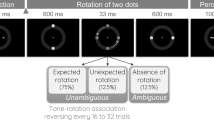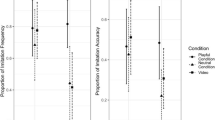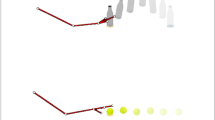Abstract
Children with autism spectrum disorder (ASD) have deficits in motor control, imitation and social function. Does a dysfunction in the neural basis of representing internal models of action contribute to these problems? We measured patterns of generalization as children learned to control a novel tool and found that the autistic brain built a stronger than normal association between self-generated motor commands and proprioceptive feedback; furthermore, the greater the reliance on proprioception, the greater the child's impairments in social function and imitation.
This is a preview of subscription content, access via your institution
Access options
Subscribe to this journal
Receive 12 print issues and online access
$209.00 per year
only $17.42 per issue
Buy this article
- Purchase on Springer Link
- Instant access to full article PDF
Prices may be subject to local taxes which are calculated during checkout


Similar content being viewed by others
References
Shadmehr, R. & Krakauer, J.W. A computational neuroanatomy for motor control. Exp. Brain Res. 185, 359–381 (2008).
Jansiewicz, E.M. et al. Motor signs distinguish children with high functioning autism and Asperger's syndrome from controls. J. Autism Dev. Disord. 36, 613–621 (2006).
Rogers, S.J., Bennetto, L., McEvoy, R. & Pennington, B.F. Imitation and pantomime in high-functioning adolescents with autism spectrum disorders. Child Dev. 67, 2060–2073 (1996).
Shadmehr, R. Generalization as a behavioral window to the neural mechanisms of learning internal models. Hum. Mov. Sci. 23, 543–568 (2004).
Hwang, E.J. & Shadmehr, R. Internal models of limb dynamics and the encoding of limb state. J. Neural Eng. 2, S266–S278 (2005).
Li, C.S.R., Padoa-Schioppa, C. & Bizzi, E. Neuronal correlates of motor performance and motor learning in the primary motor cortex of monkeys adapting to an external force field. Neuron 30, 593–607 (2001).
Xiao, J., Padoa-Schioppa, C. & Bizzi, E. Neuronal correlates of movement dynamics in the dorsal and ventral premotor area in the monkey. Exp. Brain Res. 168, 106–119 (2006).
Scott, S.H. & Kalaska, J.F. Reaching movements with similar hand paths but different arm orientation. I. Activity of individual cells in motor cortex. J. Neurophysiol. 77, 826–852 (1997).
Scott, S.H., Sergio, L.E. & Kalaska, J.F. Reaching movements with similar hand paths, but different arm orientations. II. Activity of individual cells in dorsal premotor cortex and parietal area 5. J. Neurophysiol. 78, 2413–2426 (1997).
Herbert, M.R. et al. Localization of white matter volume increase in autism and developmental language disorder. Ann. Neurol. 55, 530–540 (2004).
Mostofsky, S.H., Burgess, M.P. & Gidley Larson, J.C. Increased motor cortex white matter volume predicts motor impairment in autism. Brain 130, 2117–2122 (2007).
Oztop, E., Kawato, M. & Arbib, M. Mirror neurons and imitation: a computationally guided review. Neural Netw. 19, 254–271 (2006).
Mattar, A.A. & Gribble, P.L. Motor learning by observing. Neuron 46, 153–160 (2005).
Mostofsky, S.H. et al. Developmental dyspraxia is not limited to imitation in children with autism spectrum disorders. J. Int. Neuropsychol. Soc. 12, 314–326 (2006).
Dziuk, M.A. et al. Dyspraxia in autism: association with motor, social and communicative deficits. Dev. Med. Child Neurol. 49, 734–739 (2007).
Acknowledgements
This research was funded by grants from the National Alliance for Autism Research/Autism Speaks, the US National Institutes of Health (R01 NS037422, R01 NS048527 and K02 NS044850) and the Johns Hopkins University School of Medicine Institute for Clinical and Translational Research, a US National Institutes of Health/National Center for Research Resources Clinical and Transitional Science Award Program (UL1-RR025005).
Author information
Authors and Affiliations
Contributions
C.C.H. and J.I. conducted the robot experiments, L.R.D. conducted the social, praxis and imitation experiments and R.S. and S.H.M. wrote the manuscript.
Corresponding author
Supplementary information
Supplementary Text and Figures
Supplementary Table 1 and Supplementary Methods (PDF 60 kb)
Rights and permissions
About this article
Cite this article
Haswell, C., Izawa, J., Dowell, L. et al. Representation of internal models of action in the autistic brain. Nat Neurosci 12, 970–972 (2009). https://doi.org/10.1038/nn.2356
Received:
Accepted:
Published:
Issue Date:
DOI: https://doi.org/10.1038/nn.2356
This article is cited by
-
Müller-Lyer Illusion susceptibility is conditionally predicted by autistic trait expression
Experimental Brain Research (2024)
-
Monochannel Preference in Autism Spectrum Conditions Revealed by a Non-Visual Variant of Rubber Hand Illusion
Journal of Autism and Developmental Disorders (2022)
-
Visual and somatosensory feedback mechanisms of precision manual motor control in autism spectrum disorder
Journal of Neurodevelopmental Disorders (2021)
-
Initial action output and feedback-guided motor behaviors in autism spectrum disorder
Molecular Autism (2021)
-
Enhanced use of gaze cue in a face-following task after brief trial experience in individuals with autism spectrum disorder
Scientific Reports (2021)



